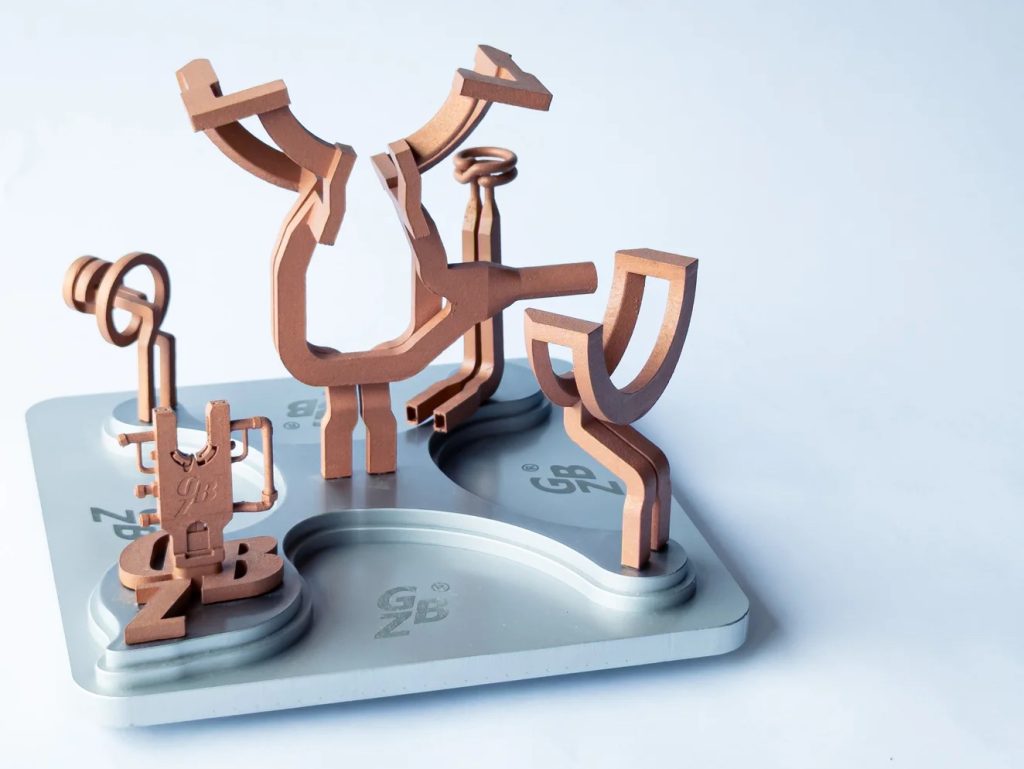Munich-based 3D printer manufacturer EOS has announced the launch of the EOS M 290 1kW laser powder bed fusion (LPBF) 3D printer.
An upgraded version of the EOS M 290 released back in 2014, this new offering incorporates a single 1kW laser and is designed for the serial production of copper and copper alloy parts.
EOS’s partner company AMCM developed the M 290 1kW as part of its custom additive manufacturing portfolio. Targeted towards applications within the space, energy and transportation sectors, the new 3D printer has reportedly already received strong market demand.
“Our award-winning EOS M 290 is one of the most widely used metal AM machines in the world, and now the family is growing. Interestingly, the EOS M 290 1kW was developed by EOS’ AMCM group as part of its custom AM portfolio,” explained Monica Smith, EOS metal product line manager.
“The call to further commercialize this platform was exceptionally strong due to market demand, so now we are slipstreaming it into EOS’ broader portfolio.”
The EOS M 290 1kW is now available for purchase alongside the company’s specially qualified Copper CuCp and CopperAlloy CuCrZr materials. Additional materials will be added to the compatibility portfolio later this year.

The new EOS M 290 1kW
In addition to its Yb-fiber 1kW laser, the EOS M 290 1kW features a build volume of 250 x 250 x 325mm (9.85 x 9.85 x 9.85in). The new 3D printer also boasts a volume rate of up to 55.4 cm³/h, scanning speeds of up to 7.0 m/s, and a focus diameter of ~ 90 μm.
Designed for industrial-scale applications, the upgraded M 290 includes a 7 Bar compressed air supply, and measures 2500 x 1300 x 2190 mm in size. As such, EOS recommends a minimum installation space of 4800 x 3600 x 2900 mm.
The EOS M 290 1kW is targeted towards the design and production of complex and high-performance copper parts such as heat exchangers and inductors. Germany-based industrial parts and tools manufacturer GBZ Mannheim GmbH & Co.KG has already adopted the new 3D printer to optimize its production process.
According to Thomas Corell, managing director at GBZ Mannheim, the 1kW laser has enabled the company to design and manufacture copper inductor parts as a single piece with no soldering points. This has reportedly enabled more capable, durable, and reproducible components to be 3D printed.
“The core elements of inductor applications are now integrated in a single build, and the results are much higher optimization of the cooling channels, lower power consumption during the product lifecycle, and we are seeing great reproducibility on the production side of things,” stated Corell.

New metal 3D printers hit the market
This is not the first time EOS has upgraded an existing metal 3D printer to increase production capacity. At Formnext 2023 the company unveiled the M 300-4 1kW, an updated version of the M 300-4 which features four 1kW lasers for the 3D printing of aluminum and copper parts.
Speaking with 3D Printing Industry Sebastian Becker, EOS’s Head of Metal Systems, stated that the M 300-4 1kW offers high productivity and a competitive cost per part of just 50 cents per cubic meter. “The M 300-4 1kW can 3D print a whole job in 30 to 35 hours. This gives us the ability to come down with cost per part, including operating costs, depreciation of the machine, and consumables like gas,” explained Becker.
Formnext 2023 also saw global engineering firm Renishaw launch its new RenAM 500 Ultra. This LPBF 3D printer offers high productivity thanks to the integration of the company’s TEMPUS technology and process monitoring software.
TEMPUS optimizes metal additive manufacturing by allowing the laser to fire during recoater movement, which minimizes laser off-time and saves up to nine seconds per layer. These time savings can ultimately cut build times by up to 50% across the entire 3D printing cycle, enabling notable time savings in the process.
Elsewhere, Chinese 3D printer manufacturer Bright Laser Technologies (BLT) released the BLT-S800, a large-scale LPBF 3D printer with an 800 x 800 x 600 mm build volume and 20 fiber lasers. The company claims that this 20-laser configuration boosts production capacity, enabling rapid production of metal parts.
What does the future of 3D printing hold?
What near-term 3D printing trends have been highlighted by industry experts?
Subscribe to the 3D Printing Industry newsletter to keep up to date with the latest 3D printing news. You can also follow us on Twitter, like our Facebook page, and subscribe to the 3D Printing Industry Youtube channel to access more exclusive content.
Are you interested in working in the additive manufacturing industry? Visit 3D Printing Jobs to view a selection of available roles and kickstart your career.
Featured image shows the EOS M 290 1kW 3D printer. Image via EOS.


